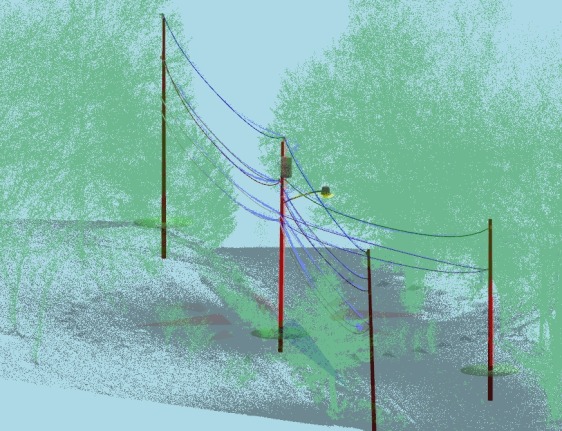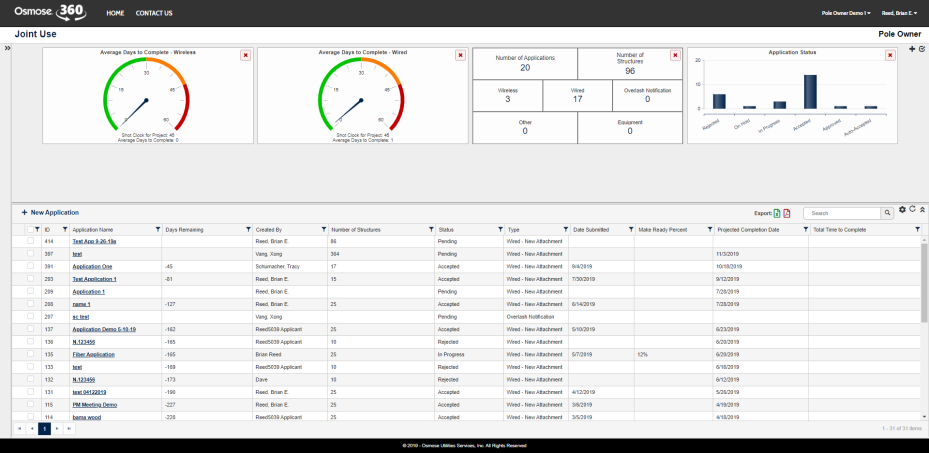5G: Here, There, and Everywhere
.webp?width=350&height=466&name=5g%20(1).webp) Wireless telecommunications networks interconnect the nation's machines and systems, fuel national economic growth, and allow millions of people to communicate daily. To enable the high speed, low latency broadband services needed for today's wireless networks, telecommunications carriers are deploying the fifth generation (5G) of wireless services.
Wireless telecommunications networks interconnect the nation's machines and systems, fuel national economic growth, and allow millions of people to communicate daily. To enable the high speed, low latency broadband services needed for today's wireless networks, telecommunications carriers are deploying the fifth generation (5G) of wireless services.
This 5G network is expected to provide technological and economic benefits to consumers, businesses, and municipalities. Critical infrastructure including utilities, hospitals, schools, transportation systems, and first responders will be profoundly impacted by the new world of 5G. Developing technologies such as Autonomous Vehicle Technology and Smart Grid Solutions such as Fault Locating, Isolation and Restoration (FLISR) will be enabled by 5G.
5G is anticipated to create an estimated three million new jobs and pump $500 billion into the economy. The telecommunications industry is positioned to spend more than $250 billion while building 5G infrastructure.
Much of the 5G network will be deployed using low level small cell antenna systems which provide wireless signal coverage over a range of less than one mile and may be constructed as close as 300 ft. to 500 ft. apart. The fiber optic cabling required for small cell backhaul and the small cell equipment, due to its small size, can and is currently being attached to utility structures such as stand-alone streetlights, traffic signals, and utility distribution poles.
Regulatory Requirements Driving Broadband Growth and Impacting Utility Pole Owners
Utility distribution poles are the backbone of the nation’s critical infrastructure and provide the pathway for the electric and telecommunications lines and equipment that power and connect the nations homes and businesses. The Federal Communications Commission (FCC) has enacted regulations requiring that investor-owned utilities and incumbent telephone local exchange carriers provide non-discriminatory access to the poles, conduits, and right of ways that are owned or controlled by the utility.
In many states, the public utilities commission (PUC) has reverse pre-empted the FCC and certified that the state will assume responsibility for the pole attachment process. Those “certified” states tend to follow the FCC provisions.
The Impact to Pole Owners
The FCC has implemented two new orders to accelerate broadband deployment that will impact pole owners in the upcoming months. The FCC’s “Accelerating Wireline” and “Accelerating Wireless” orders are forecast to result in an increase in volume of attachment requests and may require that some utilities change existing processes, add more resources, and train personnel in new skill sets to remain in compliance with current rules and regulations. Pole owners will need:
- A more organized and transparent way to process incoming attachment applications and to track and share the status of applications so they can plan next steps
- Additional field resources to perform field surveys in a timely manner to identify potential rearrangement or make-ready work
- Safe and effective approaches for measuring available clearances in the power supply and communication space to ensure National Electrical Safety Code (NESC) compliance and adherence to construction standards. And accurate methods for capturing attachment heights as inputs to pole loading software.
- Additional engineering resources to review the attachment application and support electric connection requests to power the new equipment
Preparing for Small Cell Antenna Requests
An organized, efficient approach to pole attachment management will ensure that pole owners meet the increased activity expected with the new pole attachment rules. A pole attachment management solution using skilled personnel and proven technology will ensure that a pole owner remains in compliance with regulatory requirements.
Step 1: Review Existing Agreements
The approach begins with a review of existing joint use and pole attachment agreements to determine compliance with the new regulations, responsibility for payment, and cost-recovery mechanisms for processing applications, performing surveys, and auditing pole infrastructure and attachments to those poles.
Step 2: Establish Accurate Baseline of Current Attachments (via Cost-Recoverable Audit)
 There are many levels of audits that can be performed. Some pole owners may choose to maximize the visit to the pole by audit crews and collect GPS coordinates, pole condition, circuit configurations, attachment information, note code violations, and even perform a full asset inventory from the substation to the meter. Some utilities may choose to settle for only an audit of the quantity of attachments. Regardless of whether a pole owner chooses the premium audit, settles for the minimal requirements, or chooses something in between, if it's been over five years since their last audit, a new audit should be considered to establish an accurate baseline of what’s on their poles to better prepare for the expected deployment of small cell antennas.
There are many levels of audits that can be performed. Some pole owners may choose to maximize the visit to the pole by audit crews and collect GPS coordinates, pole condition, circuit configurations, attachment information, note code violations, and even perform a full asset inventory from the substation to the meter. Some utilities may choose to settle for only an audit of the quantity of attachments. Regardless of whether a pole owner chooses the premium audit, settles for the minimal requirements, or chooses something in between, if it's been over five years since their last audit, a new audit should be considered to establish an accurate baseline of what’s on their poles to better prepare for the expected deployment of small cell antennas.
- The audit should be performed by qualified inspectors who understand both electric and telecommunications infrastructure and applicable codes such as the NESC and state orders as they may apply.
- The use of skilled technicians who are equipped with trusted field (inspection, collection, measurement) tools to collect and analyze attachments, pole condition, and to assess clearances (measured), and capture images to support next steps are an integral part of preparing an accurate baseline of current, pole condition, circuit configuration and attachment status.
- Using highly accurate Digital Measuring Technology or LiDAR combined with image recognition to collect measurements and perform detailed clearance and load assessments speeds the inspection and audit process and enables a pole owner to effectively prepare their pole plant and records.
- Once the results of the audit are collected they should be posted to a robust, map-based, online portal that allows participants in the audit to review and interact with the data relating to their attachments.
- Using a sophisticated data collection process like this delivers a faster, more accurate audit which allows the utility to assess the state of their pole plant and manage their risk exposure effectively.
Step 3: Addressing Issues Resulting from the Audit through Remediation
A properly performed audit can help a utility prepare for an expected increase in attachment requests by identifying existing code violations and substandard construction and overloaded poles, (which could delay the application process).
- Double Wood Poles: One item discovered in many audits are replaced poles remaining in the right-of-way after the pole owner utility has transferred to a new pole. These "double wood" or "buddy poles" are a sore spot with regulators and represent an unnecessary safety risk for the pole owner utility that should be addressed urgently.
- NESC/GO95 clearance violations: Caused by third party attachments are another issue. Remediation of these issues involves communication with third party stakeholders (ticket management), as well as resources to coordinate, design, schedule and review that the appropriate fixes have been performed. Performing make-ready engineering, pole loading analysis, and coordinating the movement of attachments to ensure transfers to new poles are performed expeditiously and safely is a key part of the preparing your pole plant.
Step 4: Keeping Your Pole Plant Safe and Reliable and associated Data Pristine (Turnkey Pole Application Management)
 Following the above steps, new pole attachment applications for wireline and wireless technologies must be managed effectively to ensure the safe and timely provisioning of attachment requests and compliance with regulations. Budgeting for and staffing to deal with the peaks and valleys of managing incoming applications in a timely manner is one of the biggest challenges and risks to your poles. Outsourcing the turnkey management of your Pole Application Permitting program to a company with the experience and resources to administer the program efficiently may be a solution to allow the utility to effectively manage its employee resource risk, stay in compliance with codes and regulations, and allow the utility to focus on its core business of delivering safe, reliable, and affordable energy services to its customers.
Following the above steps, new pole attachment applications for wireline and wireless technologies must be managed effectively to ensure the safe and timely provisioning of attachment requests and compliance with regulations. Budgeting for and staffing to deal with the peaks and valleys of managing incoming applications in a timely manner is one of the biggest challenges and risks to your poles. Outsourcing the turnkey management of your Pole Application Permitting program to a company with the experience and resources to administer the program efficiently may be a solution to allow the utility to effectively manage its employee resource risk, stay in compliance with codes and regulations, and allow the utility to focus on its core business of delivering safe, reliable, and affordable energy services to its customers.
A major input to a successful joint use program is continued upkeep and maintenance of field data. This can be accomplished through an online Pole Application Permitting Portal that is integrated with a utilities existing work management system. There are numerous commercial portals that can support the receipt and tracking of all new requests however the portal is only effective if you have experienced resources to perform any required application review, surveys, pole loading, make-ready design, estimating, work order writing, and post-construction audits.
Following this four-step framework will ensure that you, as a pole owner, are ready and able to respond to this burgeoning technology deployment and that the impact to your infrastructure is managed effectively, allowing you to stay in compliance with regulations, maximize your cost recovery and continue to provide benefits to your shareholders, customers, and the community you serve.
Fill out the form below for more information on how to help protect and maximize the use of your pole infrastructure and underground substructure. An Osmose representative will reach out shortly.
.png?width=243&name=Osmose-logo-(white).png)